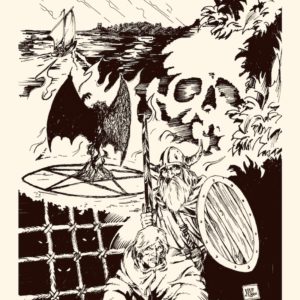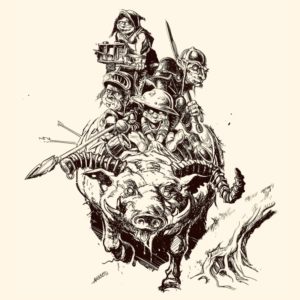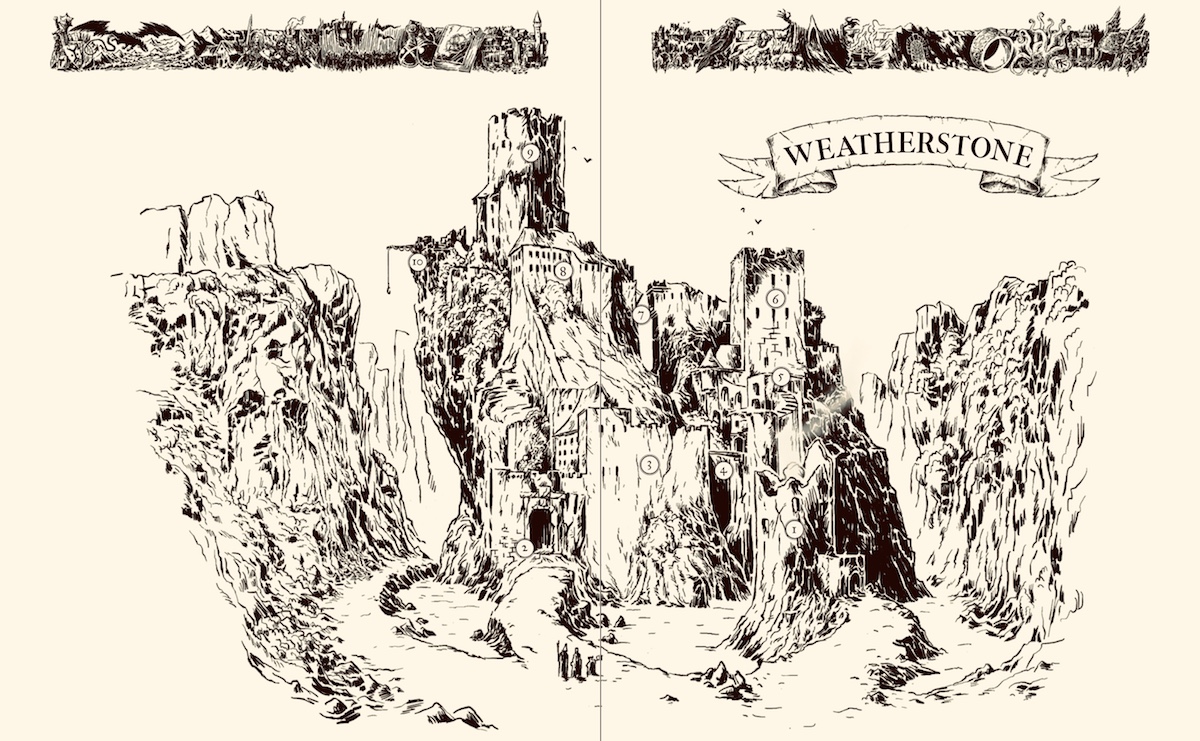Forbidden Lands is a recently translated Swedish RPG that has many elements, both mechanical and aesthetic, placing it in the old school rules/hexcrawl tradition. The crowd-funding effort billed the game as retro open-world survival fantasy. The text focuses on exploration, emphasizes that player choices should drive the narrative, announces that player character death happens, and offers many random tables to help generate content.
The art is all black and white. It reminds me of Mentzer’s edition of Basic D&D in terms of style. The tone is, at first glance, quite vanilla. There are humans, elves, dwarves, halflings, goblins, ogres, dragons, and so forth. However, details sometimes tell another, often deliciously wicked, story. For example:
Teramalda had been taken prisoner, but her armor could not be opened. The hot-headed dwarven lord Garmar Four-Beard, drunk on power and alcohol, had the priestess thrown on a bed of hot coals during the victory banquet at Lumra, to bake her like a shellfish. He swore to eat her heart himself after it had been tenderized into submission. Perhaps the god Rust chose to heed Teramalda’s prayers for martyrdom, because the armor with her scorched body suddenly tore free from its shackles, rose from the fiery coals, and killed Garmar and his bodyguards. Since that day, this creature, a rusty suit of armor, roams through Ravenland hunting for enemies to slay. (GM Guide, p. 24)
And:
Zygofer’s daughter, Therania, had taken to the young king and offered him to be her husband and slave in return for his life. When he turned her down, she had him killed, brought him back to life with her necrokinetics, and took his dead body for a lover. (GM Guide, p. 30)
On dwarves:
They claim that since the age of myth, they have built and expanded the bones of the world, a sphere so large you can barely see it curving at the horizon. The sun and stars are hearths in faraway forges the god has placed to entice the builders until they can use them when they have built their way there. … There are massive ruins across the Forbidden Lands, seemingly useless constructions the dwarves claim are the foundation for the next layer of the world. (GM Guide, p. 56-57)
On whiners:
The so-called “whiners” are small, skittish humanoids who are hunted by both orcs and humans, since they are said to have “sweet meat”. It is said their living flesh has a healing and fattening ability, so infected or deep wounds covered by parts of a whiner heal quickly. … For all these reasons, whiners are caught in traps and held in cramped cages thus allowing them to be “harvested.” This process is, of course, very painful and in the end lethal to whiners, which is why they hate all other kin … (GM Guide, p. 69)
That’s a whole lot of fantasyland names, but it’s memorable enough that I don’t even care. It feels a little bit like paint by numbers (so what are my orcs like?), but then the result ends up being creative more often than not. Undead are apparently a fact of life, just because, but “restless dead are rarely aggressive” and people often “go to the burial ground to sooth the restless dead with music and simple conversation, speaking to them as if to a child” (GM Guide, p. 45). Of course there are liches and so forth to destroy also, but these sorts of details give some parts of the official setting a pastoral, mournful air.
It is a quirky mix of precious campaign world with procedural generation and dynamic events. History, gods, and kin (what would be races in mainstream D&D lingo) take up a full 54 letter-sized pages near the start of the Gamemaster’s Guide. The setting has some elements that I would probably jettison, but I did actually read all of that material, and I usually end up bouncing off setting prose pretty quickly. I would probably replace the blood mist with something else, for example.
I will leave most discussion of game systems and mechanics for another post, but I will note that a great deal of care on the referee-facing side of things has been paid to providing functional tools that produce concrete results rather than just principles and platitudes. I have nothing against principles, but some meat on bones is nice too. The final few sections of the GM Guide (approximately 80 pages) are dedicated to guidelines for creating adventures sites, including a host of random tables, and three worked examples representing a town, a dungeon, and a castle (about 20 pages each). Some of the table entries are relatively pedestrian. The oddity of the village inn is… drum roll… a stomped floor! And the village is famous for… delicious bread! And the village oddity is… full of flowers. Wait okay that is kind of interesting; I can work with that. To conclude this overview, here is the map for the worked “castle” adventure site, Weatherstone:
The Forbidden Lands official site is here.
Purchase info
- Date: 2018-01-31
- Price: 799 Swedish Krona (approximately $90 USD)
- Details: pledge manager preorder, includes shipping
Contents:
- Forbidden Lands Boxed Set – English
- Raven’s Purge – English
- Forbidden Lands Custom Card Deck – English
- Forbidden Lands Custom Dice Set
- Soundtrack
- PDFs
See here for my approach to reviews and why I share this purchase info.




Nice review! Reviews are welcome, and this put something I hadn’t heard about at all on my radar. Cheers!